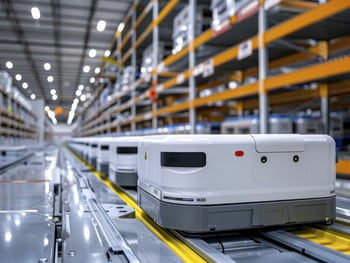
Warehouse management involves organizing and maintaining all the processes occurring in a warehouse so they run as efficiently as possible. According to a report by McKinsey & Company, about $385 billion is spent annually worldwide on warehousing costs. Even though some warehousing activities are automated, every warehouse is prone to challenges.
Warehouse problems that impact efficiency also affect productivity, costs, client relations, and bottom-line results. In many cases, errors and inefficiencies go undetected for far too long, costing the business millions. Here are some of the top efficiency challenges warehouses face and how they can address them.
1. Inaccurate Inventory Information
The Challenge: When your recorded and actual inventory numbers don’t match, this results in a number of warehouse challenges, such as stockouts, overstocking, and a misallocation of valuable resources. These problems translate to lost sales and a damaged business reputation.
The Solution: A reputable warehouse management system (WMS) can provide your business with real-time inventory tracking and automated updates. It should be combined with a solution like RFID tags or barcodes that can further automate inventory receipt and movement in real-time.
2. Adapting to Seasonal Demand
The Challenge: Changing customer demands across seasons can lead to volatile inventory if not handled appropriately. This can happen due to a lack of inventory management, poor forecasting, or difficulty in scaling operations. These challenges can result in increased costs, lost sales, and lower customer satisfaction levels.
The Solution: Using a robust WMS, your business can better predict changes in consumer demand using historical data and insights into current market conditions. This will allow you to plan resource allocation and inventory so that it matches seasonal fluctuations.
3. Inefficient Space Utilization
 The Challenge: Inefficient use of your warehouse space can result in underutilized storage areas and cluttered aisles. When your warehouse layout is poor, you are more likely to experience workflow bottlenecks, difficulty in locating inventory items, and higher overall storage costs.
The Challenge: Inefficient use of your warehouse space can result in underutilized storage areas and cluttered aisles. When your warehouse layout is poor, you are more likely to experience workflow bottlenecks, difficulty in locating inventory items, and higher overall storage costs.
The Solution: Artificial intelligence (AI) can help your business design optimize its warehouse design based on its business needs and current operations. It can analyze your current layout and suggest the best solutions, such as automated storage and retrieval systems, dynamic slotting, and using your warehouse’s vertical space.
4. Improper Labor Management
The Challenge: Labor costs can account for nearly 65% of a warehouse’s total budget. Workers are a vital part of a warehouse and managing them effectively can boost overall productivity. But, safety issues, strenuous work demands, and high turnover create many ongoing warehouse challenges.
The Solution: Focusing more on warehouse employee wellbeing and work processes can improve productivity, improve safety, and reduce turnover. For example, implementing mobile powered carts reduces the required walking employees must do daily in the warehouse.
5. Order Fulfillment Errors
The Challenge: Order fulfillment errors happen when incorrect items are picked or packed for shipping to customers. They can also occur when poor processes result in damaged items being sent to customers. These challenges can erode customer trust and harm a business’s competitive standing.
The Solution: The best way to reduce or eliminate errors is to have technology solutions in place that streamline the order fulfillment process. This can include automation solutions that reduce errors and speed up overall processing to ensure a better customer experience.
6. Substandard Picking Processes
 The Challenge: The order-picking process is one of the most labor-intensive and error-prone processes associated with order fulfillment. When it isn’t designed or run efficiently, it can lead to a poor customer experience and higher costs. Employee satisfaction can suffer as well.
The Challenge: The order-picking process is one of the most labor-intensive and error-prone processes associated with order fulfillment. When it isn’t designed or run efficiently, it can lead to a poor customer experience and higher costs. Employee satisfaction can suffer as well.
The Solution: Warehouses can improve the order picking process by choosing the strategy the makes the most sense for the warehouse design, such as wave picking or batch picking. Also, incorporating technology solutions into the picking process, such as RFID tags, pick-to-light, and mobile powered carts can drive efficiencies and reduce errors.
7. Lack of Real-Time Data Insights
The Challenge: When your warehouse doesn’t have access to real-time data insights, it loses visibility into its inventory, fulfillment status, and other workflows. This can lead to expired products, stockouts and overstocking, labor issues, equipment failures, and more.
The Solution: A modern WMS will not only allow you to manage all aspects of your business, but it will also deliver valuable real-time data insights. These insights, usually available on a user-friendly dashboard, give a clear view of all warehouse operations and can help you make better business decisions.
8. Manual Data Entry Errors
The Challenge: Manual data entry errors can occur due to outdated systems, lack of training, or simple human errors. These errors can lead to inaccurate inventory records, poor fulfillment experiences, or other inefficiencies in the warehouse, all of which are time-consuming and costly.
The Solution: The best solution is to make manual data entry as simple as possible or eliminate it completely. For example, warehouses can use mobile powered carts to bring technology to the place workers need it the most. Also, RFID tags can capture data seamlessly, eliminating the need for manual data entry.
9. Lack of Scalability
The Challenge: When market conditions provide opportunities for growth, your warehouse needs to be ready to respond quickly and efficiently. An inability to scale the business can lead to multiple errors and a poor customer experience.
The Solution: Having a well-organized and integrated system is the best way to achieve scalability. When it’s time to expand your operations, you can do so seamlessly without sacrificing productivity or incurring unnecessary costs.
10. Poor System Integration
The Challenge: When a business uses many different systems, it can create a host of challenges. For example, employees might be asked to manually enter data or transfer information from one system to another, which can lead to errors and inefficiencies. It also reduces the chances of injecting real-time visibility into the supply chain.
The Solution: Using an effective WMS that integrates inventory management, order fulfillment, billing, and other functions is the best way to improve productivity, reduce costs, and ensure data is available in real time. Instead of having employees enter data manually, you can use solutions like RIFD tags to capture information instantly.
Warehouses remain the backbone of many businesses, acting as a central hub for storage and order fulfillment. When things run smoothly, it may go unnoticed. However, when problems arise, they can impact the entire supply chain. By focusing on these inefficiencies, your warehouse can improve its productivity, reduce errors, and boost its bottom-line results.

